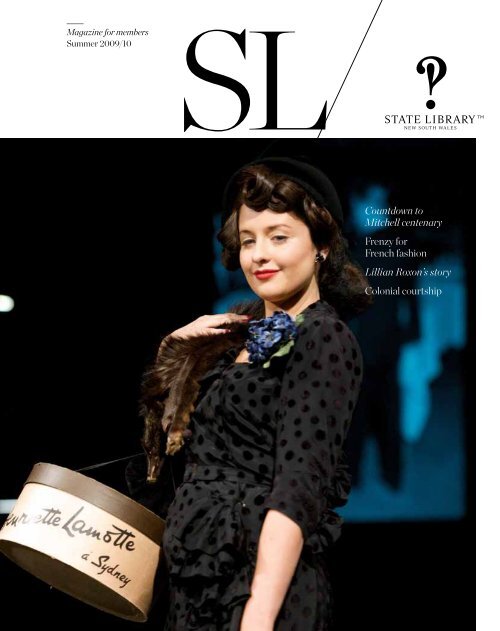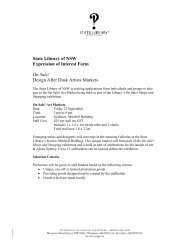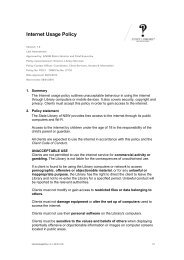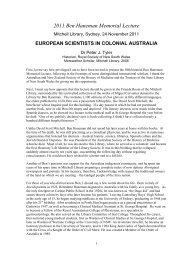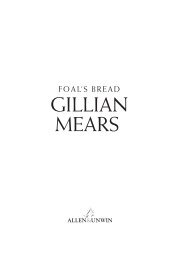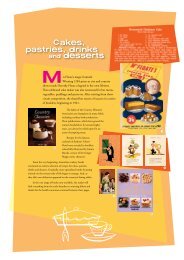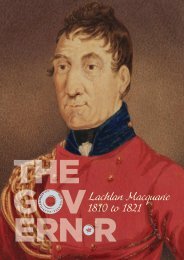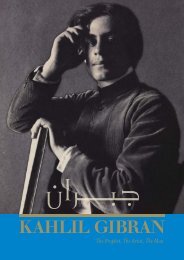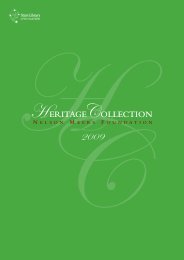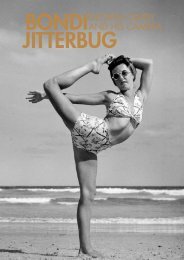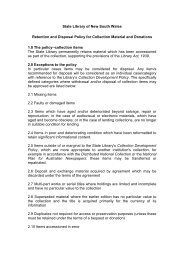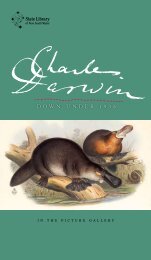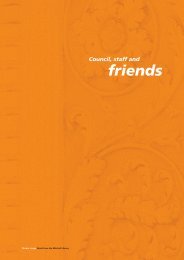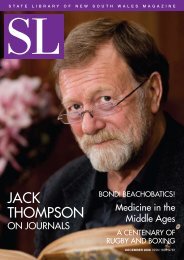Countdown to Mitchell centenary - State Library of New South Wales
Countdown to Mitchell centenary - State Library of New South Wales
Countdown to Mitchell centenary - State Library of New South Wales
Create successful ePaper yourself
Turn your PDF publications into a flip-book with our unique Google optimized e-Paper software.
–Magazine for members<br />
Summer 2009/10<br />
SL<br />
<strong>Countdown</strong> <strong>to</strong><br />
<strong>Mitchell</strong> <strong>centenary</strong><br />
Frenzy for<br />
French fashion<br />
Lillian Roxon’s s<strong>to</strong>ry<br />
Colonial courtship<br />
s l m a g a z i n e Summer 2009/10 / <strong>State</strong> <strong>Library</strong> <strong>of</strong> <strong>New</strong> <strong>South</strong> <strong>Wales</strong> / i
‘‘<br />
Message Regina Sut<strong>to</strong>n<br />
It’s hard not <strong>to</strong> feel the buzz around the <strong>Library</strong> lately (and I’m<br />
not just referring <strong>to</strong> the construction work)! The energy in the<br />
air heralds big things ahead. A major new exhibition, a dynamic<br />
website, inspiring events — so much is planned for the <strong>centenary</strong><br />
<strong>of</strong> the <strong>Mitchell</strong> <strong>Library</strong> in 2010.<br />
Read about some <strong>of</strong> the highlights in this issue <strong>of</strong> SL.<br />
Plus, there’s French fashion, colonial exploration and the<br />
<strong>New</strong> York rock scene — unexpected s<strong>to</strong>ries from our vaults.<br />
You may have noticed the magazine’s new look. We begin our<br />
next 100 years with an updated image and logo for the <strong>Library</strong>.<br />
Our new logo is based on the ‘interrobang’, a curious<br />
punctuation mark used <strong>to</strong> show questioning and surprise:<br />
a question asked () and an answer given (!). The symbol is so apt<br />
for the <strong>Library</strong> — a place where answers are found in books,<br />
original documents, online resources and from our staff.<br />
We’re continuing at an extraordinary pace <strong>to</strong> improve access<br />
<strong>to</strong> our collections. Take a look at the <strong>Library</strong>’s 2009 Annual<br />
Report, on our website soon, <strong>to</strong> see the huge amount we’ve<br />
achieved in the past year. We’ve created 30,000 digital images<br />
from manuscripts and artworks, and 182,500 electronic<br />
catalogue records.<br />
You’ll see more and more rare material brought online, with<br />
an enhanced digitisation strategy led by our new Digitisation<br />
and Imaging Manager, Rory McLeod, who joins us from the<br />
British <strong>Library</strong>. Already Rory and his team are looking for<br />
exciting ways <strong>to</strong> increase access <strong>to</strong> the most in-demand items,<br />
as well as safe ways <strong>to</strong> preserve digital content over time.<br />
Whether you visit us online or at Macquarie Street, you’ll<br />
experience our collections in surprising ways. See the stunning<br />
<strong>centenary</strong> alphabet on display near the <strong>State</strong> Reference <strong>Library</strong>,<br />
and revealed letter-by-letter on the dedicated 2010 website.<br />
And find out why the <strong>Library</strong> has handmade bird whistles,<br />
a cow horn and Dame Nellie Melba’s Cartier hairpin case,<br />
when you visit the Stranger than Fiction display.<br />
As part <strong>of</strong> renewing our relationship with Foundation<br />
supporters, we’ll be providing better value <strong>to</strong> members.<br />
SL magazine is now available exclusively <strong>to</strong> Friends, Members<br />
and Volunteers. A range <strong>of</strong> added benefits will be delivered<br />
next year.<br />
We look forward <strong>to</strong> celebrating our <strong>centenary</strong> in 2010<br />
with you!<br />
Regina sut<strong>to</strong>n<br />
NSW <strong>State</strong> Librarian & Chief Executive<br />
‘
ontents<br />
‘<br />
cSummer 2009/10<br />
SL<br />
The magazine for<br />
foundaTion members,<br />
friends and VolunTeers<br />
is published quarTerly<br />
by The library CounCil<br />
<strong>of</strong> nsW.<br />
edi<strong>to</strong>R<br />
CaThy perkins<br />
Cperkins@sl.nsW.goV.au<br />
design & PRoduction<br />
dominiC hon<br />
Pho<strong>to</strong>gRaPhy<br />
unless oTherWise sTaTed,<br />
all phoTographiC/<br />
imaging Work is by<br />
sCoTT Wajon and bruCe<br />
york, imaging serViCes,<br />
sTaTe library <strong>of</strong> nsW.<br />
concePt & tyPogRaPhic<br />
diRection<br />
frosT design<br />
PRinting<br />
pegasus prinT group<br />
PaPeR<br />
raleigh paper<br />
eCosTar 200 gsm (CoVer)<br />
and 120 gsm (TexT) is<br />
made Carbon neuTral<br />
and The fibre sourCe has<br />
been independenTly<br />
CerTified by The foresT<br />
sTeWardship CounCil<br />
(fsC). eCosTar is<br />
manufaCTured from 100%<br />
posT Consumer reCyCled<br />
paper in a proCess<br />
Chlorine free<br />
enVironmenT under The<br />
iso 14001 enVironmenTal<br />
managemenT sysTem.<br />
summer 2009/10<br />
Vol. 2 no. 3<br />
issn 1835-9787<br />
p&d-3111-12/2009<br />
prinT run 3000<br />
state libRaRy <strong>of</strong> nsW<br />
maCquarie sTreeT<br />
sydney nsW 2000<br />
phone 02 9273 1414<br />
fax 02 9273 1255<br />
email<br />
library@sl.nsW.goV.au<br />
WWW.sl.nsW.goV.au<br />
oPening houRs<br />
monday To Thursday<br />
9 am To 8 pm<br />
friday 9 am To 5 pm<br />
Weekends 10 am To 5 pm<br />
The miTChell library<br />
reading room is Closed<br />
on sundays.<br />
fRont coveR<br />
from The library’s<br />
preT-a-porTer fashion<br />
parade. afTernoon<br />
dress by emmeline<br />
manassé, rue sT honore,<br />
paris, C. 1948, darnell<br />
ColleCTion, sydney,<br />
model anneTTe TWemloW,<br />
phoTo by louise Whelan<br />
back coveR<br />
bird WhisTles, 1960s,<br />
henry graCe, Tin and<br />
brass, r408–17<br />
oPPosite<br />
phoTo by dieu Tan<br />
2 celebRating<br />
ONE hundred years <strong>of</strong><br />
the <strong>Mitchell</strong> <strong>Library</strong><br />
6 neWs<br />
Open for business<br />
eRecords for<br />
remarkable bibles<br />
First Fleet journals<br />
recognised by<br />
UNESCO<br />
Future <strong>of</strong> libraries<br />
<strong>New</strong> research<br />
partnership: His<strong>to</strong>ry<br />
<strong>of</strong> climate change<br />
8 on this day …<br />
10 featuRe<br />
Frenzy for<br />
French fashion<br />
16 featuRe<br />
In<strong>to</strong> the interior<br />
20 featuRe<br />
Mother <strong>of</strong> rock:<br />
Lillian Roxon’s s<strong>to</strong>ry<br />
24 neW acquisitions<br />
A second exposure<br />
Above the traffic<br />
26 a living collection<br />
Colonial courtship<br />
28 building a stRong<br />
foundation<br />
30 foR ouR fRiends<br />
3 1 Recent highlights<br />
32 the libRaRy shoP<br />
<strong>New</strong> books and<br />
merchandise<br />
33 q&a<br />
Raimond Gaita<br />
s l m a g a z i n e Summer 2009/10 / <strong>State</strong> <strong>Library</strong> <strong>of</strong> <strong>New</strong> <strong>South</strong> <strong>Wales</strong> / 1
To overrate the<br />
<strong>of</strong> the lib<br />
aid <strong>to</strong> the<br />
his <strong>of</strong><br />
would<br />
2 / s l m a g a z i n e Summer 2009/10 / <strong>State</strong> <strong>Library</strong> <strong>of</strong> <strong>New</strong> <strong>South</strong> <strong>Wales</strong>
value<br />
rary as an<br />
study<br />
<strong>to</strong>ry<br />
<strong>of</strong> the<br />
Australia<br />
Celebrating 100 years<br />
<strong>of</strong> the MitChell library<br />
in 2010<br />
be impossible …<br />
lord Chelmsford, goVernor <strong>of</strong> nsW,<br />
miTChell library opening, 8 marCh 1910<br />
s l m a g a z i n e Summer 2009/10 / <strong>State</strong> <strong>Library</strong> <strong>of</strong> <strong>New</strong> <strong>South</strong> <strong>Wales</strong> / 3
Celebrating<br />
ONE hundred years<br />
<strong>of</strong> the <strong>Mitchell</strong> <strong>Library</strong>
In 2010 we’re celebrating the <strong>centenary</strong> <strong>of</strong> the <br />
<strong>Mitchell</strong> <strong>Library</strong>. On 9 March for 100 days a <br />
major exhibition will display 100 <strong>of</strong> our most <br />
intriguing items. ONE hundred is a rollcall <strong>of</strong> the <br />
famous and the no<strong>to</strong>rious from Australia’s past, <br />
the quiet achievers and the noisy larrikins, <br />
the conventional and the rebellious, <br />
the remembered and the forgotten — <br />
all have a fascinating s<strong>to</strong>ry <strong>to</strong> tell. <br />
Bringing the<br />
collection OUT<br />
Throughout 2010 we’re bringing the<br />
<strong>Mitchell</strong> collection out <strong>of</strong> the vaults.<br />
The <strong>Mitchell</strong> <strong>Library</strong> began with the<br />
personal collection <strong>of</strong> David Scott<br />
<strong>Mitchell</strong>, who bequeathed over 40,000<br />
works and a large endowment <strong>to</strong> the<br />
people <strong>of</strong> NSW. The <strong>Library</strong> has been<br />
adding <strong>to</strong> it ever since. In our <strong>centenary</strong><br />
year there are lots <strong>of</strong> surprises in s<strong>to</strong>re,<br />
with behind-the-scenes <strong>to</strong>urs, regional<br />
Our new<br />
alphabet <strong>Countdown</strong><br />
displays and a virtual time capsule. We’ve created an alphabet Follow the countdown <strong>to</strong> the<br />
that brings out the broad and ONE hundred exhibition <br />
eclectic collections <strong>of</strong> the opening on our <strong>centenary</strong> <br />
<strong>State</strong> <strong>Library</strong> in an unexpected micro-site. Check out the <br />
way. With the original concept release <strong>of</strong> our alphabet — <br />
by Frost Design, each letter is a couple <strong>of</strong> letters per week — <br />
made up <strong>of</strong> elements from and the full program <strong>of</strong> events <br />
maps, manuscripts, ephemera, and activities celebrating the <br />
relics and even <strong>Library</strong><br />
<strong>Mitchell</strong> <strong>Library</strong> <strong>centenary</strong>.<br />
architecture. The alphabet, www.onehundred.sl.nsw.gov.au<br />
and the many s<strong>to</strong>ries it tells, <br />
will extend well beyond the <br />
<strong>Mitchell</strong> <strong>centenary</strong> year. <br />
s l m a g a z i n e Summer 2009/10 / <strong>State</strong> <strong>Library</strong> <strong>of</strong> <strong>New</strong> <strong>South</strong> <strong>Wales</strong> / 5
Open for <br />
business<br />
In preparation for our<br />
<strong>centenary</strong> celebrations in<br />
2010, we’re undertaking<br />
essential building work.<br />
The <strong>Mitchell</strong> <strong>Library</strong> reading<br />
room remains open, but the<br />
external doors will be closed<br />
during this time. Please enter<br />
through the Macquarie Street<br />
wing. The improvements will<br />
leave us with a refurbished<br />
gallery space, more visi<strong>to</strong>rfriendly<br />
public areas and a<br />
new air-conditioning system.<br />
The Galleries will reopen<br />
on 9 March 2010 for the<br />
ONE hundred exhibition.<br />
eRecords for remarkable Bibles<br />
You can now search online for thousands <strong>of</strong> titles in the <strong>State</strong> <strong>Library</strong><br />
collections that could previously be found only through the card<br />
catalogue. A collection <strong>of</strong> rare Bibles is among the 180,000 items that<br />
have new eRecords.<br />
The Bible that gave us such popular phrases as ‘<strong>to</strong> pour out one’s heart’,<br />
‘pride goes before a fall’ and ‘<strong>to</strong> fall flat on his face’ — the King James or<br />
Authorised Version <strong>of</strong> 1611 — is represented in several editions. There are<br />
oversized and miniature Bibles, including a tiny <strong>New</strong> Testament from 1598<br />
that’s one <strong>of</strong> the earliest examples <strong>of</strong> miniature book production.<br />
The family who donated the Bibles <strong>to</strong> the <strong>Library</strong> in 1926, the<br />
Richardsons, believed they were related <strong>to</strong> bible publisher and martyr John<br />
Rogers. Rogers was burnt at the stake in 1555 for printing a Bible in English.<br />
The fascinating his<strong>to</strong>ry <strong>of</strong> Bible publishing in England reflects social,<br />
political and religious upheavals from the 16th century <strong>to</strong> <strong>to</strong>day.<br />
image: seleCTion from The riChardson bible ColleCTion<br />
6 / s l m a g a z i n e Summer 2009/10 / <strong>State</strong> <strong>Library</strong> <strong>of</strong> <strong>New</strong> <strong>South</strong> <strong>Wales</strong>
n e w s<br />
First Fleet<br />
journals<br />
recognised<br />
by UNESCO<br />
Our unrivalled collection<br />
<strong>of</strong> First Fleet journals was<br />
recently added <strong>to</strong> the<br />
UNESCO Australia Memory<br />
<strong>of</strong> the World Register. The<br />
<strong>Library</strong> holds nine <strong>of</strong> the<br />
11 First Fleet journals known<br />
<strong>to</strong> exist, providing first-hand<br />
accounts <strong>of</strong> the voyage <strong>to</strong><br />
Australia and early settlement<br />
from 1787 <strong>to</strong> the 1790s.<br />
The Memory <strong>of</strong> the World<br />
program aims <strong>to</strong> safeguard<br />
and raise awareness <strong>of</strong> the<br />
documentary heritage <strong>of</strong><br />
humanity. The First Fleet<br />
journals are available <strong>to</strong> read<br />
on our website.<br />
image: boTany bay (deTail), 1788,<br />
Charles gore, WaTerColour, dg V1a/8<br />
Future <strong>of</strong><br />
libraries<br />
How will the global financial<br />
crisis, climate change and an<br />
ageing population change and<br />
shape NSW public libraries in<br />
the future What will be the<br />
effect <strong>of</strong> technologies such as<br />
e-books and web 2.0 Research<br />
by the <strong>State</strong> <strong>Library</strong> and NSW<br />
public libraries has looked at<br />
future scenarios that could<br />
affect public libraries over the<br />
next 20 years, and ways we can<br />
respond <strong>to</strong> change. A report,<br />
The Bookends Scenarios:<br />
Alternative Futures for the<br />
Public <strong>Library</strong> Network in<br />
NSW in 2030, was recently<br />
prepared by Neville Freeman<br />
Agency and will be<br />
available on our website.<br />
<strong>New</strong> research<br />
partnership:<br />
His<strong>to</strong>ry <strong>of</strong> <br />
climate change<br />
A research team from the University <strong>of</strong> Melbourne<br />
has partnered with the <strong>State</strong> <strong>Library</strong> <strong>of</strong> NSW and<br />
other key libraries <strong>to</strong> develop a climate his<strong>to</strong>ry for<br />
south-eastern Australia. Surprisingly, climate<br />
records such as temperature and rainfall<br />
measurements have only been kept <strong>of</strong>ficially in<br />
Australia for about 100 years. If it hadn’t been for<br />
early European explorers and settlers, we would have<br />
few accounts <strong>of</strong> weather patterns pre-dating the<br />
1900s. The landmark project, led by Dr Joelle Gergis<br />
and Pr<strong>of</strong>essor David Karoly, will comb the <strong>Library</strong>’s<br />
archives <strong>to</strong> capture Australia’s climatic past and<br />
help determine the extent <strong>of</strong> human-caused<br />
climate change.<br />
image: fenCing aT breWarrina (deTail), 2002, darren Clark, pxa 1069<br />
s l m a g a z i n e Summer 2009/10 / <strong>State</strong> <strong>Library</strong> <strong>of</strong> <strong>New</strong> <strong>South</strong> <strong>Wales</strong> / 7
22 December 1888<br />
The Bulletin publishes the first <br />
short s<strong>to</strong>ry by Henry Lawson, <br />
aged 21, entitled ‘His Father’s <br />
Mate’.<br />
image: pen WiTh sTand <br />
oWned by henry laWson <br />
C. 1900, r 64<br />
1 January 1810<br />
Lachlan Macquarie becomes<br />
Governor <strong>of</strong> NSW. In his own<br />
words, Macquarie ‘found the<br />
colony barely emerging from<br />
infantile imbecility’ and left it<br />
‘enjoying a state <strong>of</strong> private<br />
comfort and public<br />
prosperity’.<br />
image: laChlan maCquarie, C. 1819<br />
WaTerColour on iVory miniaTure<br />
min 236<br />
24 December 1789<br />
The convict ship Guardian<br />
strikes ice en route <strong>to</strong> save<br />
the starving colony <strong>of</strong> NSW.<br />
The dramatic wreck made<br />
international headlines and<br />
resulted in conditional<br />
pardons for 14 <strong>of</strong> the surviving<br />
convicts.<br />
17 January 1877<br />
May Gibbs, children’s book<br />
illustra<strong>to</strong>r and crea<strong>to</strong>r <strong>of</strong><br />
Snuggle Pot and Cuddle Pie,<br />
is born at Cowell, <strong>South</strong><br />
Australia.<br />
CapTion: ‘danCing’, 1918<br />
illusTraTion by may gibbs for<br />
Snuggle Pot and Cuddle Pie<br />
pxd 304/V.2/153<br />
image: the PerilouS Situation <strong>of</strong> ‘the<br />
guardian’ frigate … possibly by roberT<br />
dighTon, C. 1790, pen, ink and<br />
WaTerColour, ml 1112 (b)<br />
8 / s l m a g a z i n e Summer 2009/10 / <strong>State</strong> <strong>Library</strong> <strong>of</strong> <strong>New</strong> <strong>South</strong> <strong>Wales</strong>
day<br />
on this<br />
2 February 1966<br />
Protests take place in Sydney during the<br />
intake <strong>of</strong> conscripts for the Vietnam War.<br />
image: VieTnam War proTesTer<br />
1966, on 173<br />
23 February 1931<br />
Internationally renowned<br />
opera singer Dame Nellie<br />
Melba dies in Sydney. Melba<br />
was made a Dame Commander<br />
<strong>of</strong> the British Empire in 1918<br />
for services <strong>to</strong> World War I.<br />
image: nellie melba (deTail)<br />
1903, phoTo by Talma & Co<br />
p1/melba, nellie (bm)<br />
coRRection<br />
In ‘On this day’<br />
SL August 2009<br />
(p. 21), a picture <strong>of</strong><br />
Governor Phillip’s<br />
farm was<br />
incorrectly<br />
captioned as<br />
belonging <strong>to</strong><br />
James Ruse.<br />
s l m a g a z i n e Summer 2009/10 / <strong>State</strong> <strong>Library</strong> <strong>of</strong> <strong>New</strong> <strong>South</strong> <strong>Wales</strong> / 9
f e a t u r e<br />
f r e n z y<br />
for<br />
French Fashion<br />
W o R d s Margot Riley<br />
10 / s l m a g a z i n e Summer 2009/10 / <strong>State</strong> <strong>Library</strong> <strong>of</strong> <strong>New</strong> <strong>South</strong> <strong>Wales</strong>
In July 1948 Sydney audiences were<br />
treated <strong>to</strong> the first complete collection<br />
<strong>of</strong> Christian Dior’s revolutionary<br />
‘<strong>New</strong> Look’ fashions shown outside<br />
Paris. Through pho<strong>to</strong>graphs, personal<br />
papers and magazines, cura<strong>to</strong>r<br />
Margot Riley has uncovered surprising<br />
insights in<strong>to</strong> the events that led <strong>to</strong><br />
this defining moment. It’s the s<strong>to</strong>ry<br />
behind this year’s sell-out Pret-aporter<br />
Fashion Parade, presented<br />
by the <strong>Library</strong> at the S<strong>of</strong>itel Sydney<br />
Wentworth.<br />
lefT: madame<br />
ChambrelenT models The<br />
signaTure ‘bar’ suiT from<br />
ChrisTian dior’s firsT<br />
‘neW look’ ColleCTion,<br />
auStralian Women’S<br />
Weekly, 9 augusT 1947<br />
beloW: ‘sTyle symposium<br />
from paris’, auStralian<br />
Women’S Weekly,<br />
21 sepTember 1946<br />
opposiTe: baCk sTage,<br />
deparTmenT sTore<br />
fashion parade, mark<br />
foy’s, sydney, marCh 1947,<br />
Pix arChiVe, aCp<br />
From wine and wool <strong>to</strong> food and fashion, the French<br />
have always had a thing or two <strong>to</strong> teach Australians<br />
about the art <strong>of</strong> combining business and pleasure.<br />
Having supplied the French fashion industry with<br />
wool for nearly a century, Australia became an eager<br />
participant in the global market for French style after<br />
World War II.<br />
Anxious <strong>to</strong> cut out the British middle men, French<br />
textile companies had been buying wool directly<br />
from Australia since the 1850s. When the wool trade<br />
<strong>to</strong>ok <strong>of</strong>f during the second half <strong>of</strong> the century, France<br />
became Australia’s largest cus<strong>to</strong>mer after Britain.<br />
By 1900, Australia was leading the world in the<br />
production <strong>of</strong> fine merino wool and many French<br />
wool-buying firms had representatives stationed<br />
here permanently.<br />
It is hard <strong>to</strong> overestimate the influence <strong>of</strong> the<br />
wool-buyers and their coterie on Australian attitudes<br />
<strong>to</strong> French culture at this time. Bringing with them a<br />
taste for Parisian luxuries and the sophistication <strong>of</strong><br />
European city life, the elegant subset <strong>of</strong> Sydney<br />
society (known as le <strong>to</strong>ut-Sydney) ensured that a<br />
French fixation thrived.<br />
This was an era in which an elegant woman<br />
might change outfits four times a day — for travelling,<br />
lunching and visiting, going <strong>to</strong> the races, cocktails,<br />
dinner and balls. But only the very wealthy could<br />
s l m a g a z i n e Summer 2009/10 / <strong>State</strong> <strong>Library</strong> <strong>of</strong> <strong>New</strong> <strong>South</strong> <strong>Wales</strong> / 11
f r e n z y f o r f r e n C h f a s h i o n<br />
experience first-hand the rarefied ambience <strong>of</strong><br />
Parisian haute couture (high fashion) houses. For the<br />
small number <strong>of</strong> Australians who travelled regularly<br />
and could afford it, haute couture could be purchased<br />
directly from these exclusive establishments,<br />
provided one had the right introductions, and the<br />
time <strong>to</strong> undertake several fittings and wait a month<br />
for the garments <strong>to</strong> be completed.<br />
Back home, several couture salons had opened in<br />
Sydney during the interwar period. Bearing French<br />
names, and cashing in on the prestige <strong>of</strong> Paris fashion<br />
and all things French, these businesses modelled<br />
their operations on French workrooms. Local<br />
couturiers like Madam Rochas, Paulette Pellier,<br />
Germaine Rocher, and milliner Henriette Lamotte,<br />
numbered among their clientele the wives and<br />
daughters <strong>of</strong> successful business men, female<br />
members <strong>of</strong> important Australian families and<br />
leading Sydney socialites.<br />
Australian women could also buy French fashion<br />
through the better department s<strong>to</strong>res such as<br />
Sydney’s Mark Foys and David Jones. The latter<br />
was particularly noted for its French salon,<br />
where shoppers could select from an array <strong>of</strong><br />
ready-made gowns.<br />
By the end <strong>of</strong> World War II, people were ready <strong>to</strong><br />
indulge themselves after years <strong>of</strong> wartime austerity.<br />
The troops came home <strong>to</strong> their families and women<br />
longed for romance and feminine clothes, but little<br />
was happening in the Australian garment industry.<br />
Due <strong>to</strong> a lack <strong>of</strong> materials and labour, there was a<br />
shortage <strong>of</strong> apparel in the s<strong>to</strong>res. In an attempt <strong>to</strong><br />
stimulate the local rag trade and revitalise<br />
production, several leading businessmen teamed up<br />
<strong>to</strong> bring an exhibition <strong>of</strong> French haute couture<br />
fashion <strong>to</strong> Australia.<br />
Department s<strong>to</strong>re owners Norman Myer (Myer,<br />
Melbourne and Adelaide) and Charles Lloyd Jones<br />
(David Jones, Sydney) were keen <strong>to</strong> whet the fashionstarved<br />
appetites <strong>of</strong> their cus<strong>to</strong>mers and encourage<br />
consumer spending. Frank Packer, owner <strong>of</strong> the<br />
Australian Women’s Weekly, was anxious <strong>to</strong> woo<br />
the David Jones advertising account over <strong>to</strong> his<br />
publications.<br />
In early 1946, Mary Hordern, fashion edi<strong>to</strong>r<br />
<strong>of</strong> the Weekly and Packer’s sister-in-law, was sent<br />
<strong>to</strong> Paris <strong>to</strong> choose the collection <strong>of</strong> French fashions<br />
<strong>to</strong> be paraded around the country. A powerful local<br />
authority on fashion, Hordern was an attractive<br />
woman with a statuesque figure well-suited <strong>to</strong><br />
wearing the clothes she wrote about. It was her<br />
idea <strong>to</strong> recruit four Parisian mannequins <strong>to</strong> show<br />
Australian audiences how these clothes should<br />
be worn.<br />
Hordern inspected some 5000 garments over a<br />
three-month period, selecting 120 ensembles that<br />
represented the essence <strong>of</strong> French fashion yet were<br />
suited <strong>to</strong> Australian life. Each outfit was fully<br />
accessorised, and ranged from simple clothes for<br />
specta<strong>to</strong>r sports and the beach <strong>to</strong> evening gowns.<br />
lefT: ‘The ausTralian<br />
Women’s Weekly paris<br />
fashion parade’, CoVer,<br />
auStralian Women’S<br />
Weekly, 21 sepTember 1946<br />
opposiTe: frenCh fashion<br />
parade, prinCe’s<br />
resTauranT, sydney, 1956,<br />
phoTograph by<br />
jaCk hiCkson, apa 01445<br />
12 / s l m a g a z i n e Summer 2009/10 / <strong>State</strong> <strong>Library</strong> <strong>of</strong> <strong>New</strong> <strong>South</strong> <strong>Wales</strong>
Successive issues <strong>of</strong> the Weekly reported every aspect<br />
<strong>of</strong> Horden’s experience in Paris, declaring that<br />
‘Fabrics — even prewar fabrics — have never been<br />
lovelier’. All the ‘woolens were woven from<br />
Australian wool’, and readers were reminded that the<br />
French appreciated the quality <strong>of</strong> our fine fleece over<br />
the embellishments added by their designers.<br />
Under the supervision <strong>of</strong> Caroline Chambrelent,<br />
Directress <strong>of</strong> the House <strong>of</strong> Worth, the French<br />
mannequins made the gruelling six-day flight from<br />
Paris by flying boat. Arriving in August <strong>to</strong> begin<br />
their <strong>to</strong>ur, the women quickly became the <strong>to</strong>ast<br />
<strong>of</strong> the <strong>to</strong>wn.<br />
Staged with all the glamour <strong>of</strong> a Rue de la Paix<br />
salon, the French fashion parades opened in the<br />
Grand Ballroom <strong>of</strong> David Jones’ Elizabeth Street<br />
s<strong>to</strong>re on 16 September 1946. Sydney women flocked<br />
<strong>to</strong> the twice-daily showings just as eager <strong>to</strong> catch a<br />
glimpse <strong>of</strong> the stunning mannequins as the garments<br />
themselves, which few could have afforded and were<br />
not for sale anyway.<br />
The <strong>to</strong>ur continued on <strong>to</strong> Myer in Melbourne<br />
and Adelaide, and Finney Isles in Brisbane. The<br />
parades became famous, boosting the Weekly’s sales<br />
(circulation 700,000 in 1946) and encouraging the<br />
magazine <strong>to</strong> stage three more French fashion<br />
extravaganzas in 1947, 1948 and 1949.<br />
While the parades brought thousands <strong>of</strong> cus<strong>to</strong>mers<br />
in<strong>to</strong> the department s<strong>to</strong>res, Mary Hordern’s failure <strong>to</strong><br />
secure local manufacturing licences was perceived,<br />
by David Jones in particular, as a lost merchandising<br />
opportunity.<br />
In 1947 David Jones launched its ‘Paris Fashion for<br />
All’ policy, with the intention <strong>of</strong> securing licences <strong>to</strong><br />
reproduce Australian adaptations <strong>of</strong> French model<br />
garments in their Surry Hills workrooms.<br />
It was also the year Christian Dior launched his<br />
first collection in Paris. Dubbed the ‘<strong>New</strong> Look’, it put<br />
French fashion on the front page <strong>of</strong> newspapers all<br />
over the world, rendering existing styles démodé<br />
overnight. To a wartime generation, Dior’s fashions<br />
embodied the rediscovery <strong>of</strong> happiness, with his<br />
extravagant use <strong>of</strong> fabric, sweeping skirts and nippedin<br />
waists perfectly timed <strong>to</strong> satisfy a world starved<br />
<strong>of</strong> luxury, beauty and glamour. Soon after the ‘<strong>New</strong><br />
Look’ debuted in February, David Jones secured a<br />
franchise with the House <strong>of</strong> Dior.<br />
s l m a g a z i n e Summer 2009/10 / <strong>State</strong> <strong>Library</strong> <strong>of</strong> <strong>New</strong> <strong>South</strong> <strong>Wales</strong> / 13
f r e n z y f o r f r e n C h f a s h i o n<br />
At the 1947 Spring Paris openings, Australia was<br />
the biggest buyer, with David Jones becoming the<br />
first Australian retailer <strong>to</strong> purchase a complete haute<br />
couture collection. Sixty model garments, by various<br />
designers, were airmailed out <strong>to</strong> Sydney with a<br />
complete range <strong>of</strong> accessories so David Jones’<br />
cus<strong>to</strong>mers would see the <strong>to</strong>ut ensemble as paraded<br />
in Paris.<br />
For the gala opening, on 18 July, 800 people packed<br />
the Bois de Rose salon, specially created on the fourth<br />
floor <strong>of</strong> David Jones’ Elizabeth Street s<strong>to</strong>re, where<br />
the French garments were shown, side-by-side, with<br />
their Australian adaptations.<br />
The benefit <strong>of</strong> David Jones’ ‘Paris Fashion for All’<br />
parades was threefold: for the first time the average<br />
Australian consumer had access <strong>to</strong> current season<br />
French fashion and French designs adapted <strong>to</strong> the<br />
Australian climate and lifestyle; Australian<br />
mannequins gained valuable career experience in<br />
parading high fashion garments; and Australian<br />
workers were trained in Parisian haute couture<br />
methods <strong>of</strong> cutting, construction and finishing.<br />
In the space <strong>of</strong> a year, Christian Dior<br />
re-established Paris as the heart <strong>of</strong> fashion<br />
innovation, and his follow-up collection for spring<br />
1948 was the most anticipated and watched spectacle<br />
<strong>of</strong> the fashion world.<br />
On the local scene, David Jones staged a further<br />
coup over its rivals by securing ‘the first Dior-only<br />
collection <strong>to</strong> be shown outside Paris’, for its spring<br />
1948 parades. ‘<strong>New</strong> Look’ garments from this his<strong>to</strong>ric<br />
collection would be shown in Australia before being<br />
seen anywhere else in the world, with local<br />
adaptations available for sale.<br />
Dior collaborated with David Jones because he<br />
knew that very few Australians had the chance <strong>to</strong><br />
visit Paris. He acknowledged Australia’s enthusiasm<br />
for his extravagant designs, which had attracted<br />
criticism in Europe. Perhaps local audiences saw his<br />
generous use <strong>of</strong> materials as a much-needed stimulus<br />
<strong>to</strong> Australian wool and cot<strong>to</strong>n producers. ‘Living in<br />
the sunshine <strong>of</strong> a comparatively new country,<br />
unscathed by war,’ Dior <strong>to</strong>ld the Sydney Morning<br />
Herald, ‘the Australians have a cleaner brighter<br />
outlook and are more receptive <strong>to</strong> new ideas than the<br />
tired people <strong>of</strong> Europe.’<br />
The couturier despatched 10 packing crates <strong>to</strong><br />
Australia containing the original model garments<br />
selected by David Jones’ fashion buyer Alice Condon,<br />
along with Dior-designed hats and accessories.<br />
Arriving on 25 June 1948, the garments from his<br />
Envol (flight) and Zig Zag lines were carefully<br />
unpacked and minutely examined in the David Jones’<br />
workrooms. A range <strong>of</strong> adaptations was then<br />
designed and manufactured, faithfully reproducing<br />
the superb workmanship <strong>of</strong> Paris haute couture.<br />
On opening night in late July, the social set was far<br />
outnumbered by members <strong>of</strong> the Sydney fashion<br />
trade, armed with paper and pencils <strong>to</strong> sketch the<br />
styles and coiffures. Alongside the 50 Dior originals<br />
and 34 Australian adaptations, David Jones’ 1948<br />
spring/summer collection included designs from the<br />
houses <strong>of</strong> Paquin, Carven, Gres, Lelong, Piguet and<br />
Jacques Fath, as well as 25 garments specially<br />
designed by Pierre Balmain for the Australian<br />
market. The ensembles were paraded by<br />
12 Australian mannequins matched <strong>to</strong> the exact<br />
measurements and colouring <strong>of</strong> Dior’s house models<br />
for whom the original gowns had been created.<br />
The tiny 19-inch waist <strong>of</strong> model Narelle Findlay,<br />
in particular, caused quite a stir.<br />
As well as capturing the imagination <strong>of</strong> the<br />
Australian buying public, the frenzy for French<br />
fashion stimulated local designers and<br />
manufacturers <strong>to</strong> such an extent that 1950 saw the<br />
inauguration <strong>of</strong> the Australian Fashion Fair. Madame<br />
Chambrelent (now Mrs Kenneth Cole and a resident)<br />
was given the task <strong>of</strong> organising this first Australianonly<br />
fashion exhibition, concluding in the Weekly:<br />
‘In the 4 years since I first visited Australia<br />
I have been greatly impressed with the rapid<br />
development <strong>of</strong> the fashions [by local designers] and<br />
feel sure that Australia should soon become one <strong>of</strong><br />
the world’s youngest fashion leaders.’<br />
opposiTe: This runWay<br />
look from The library’s<br />
preT-a-porTer fashion<br />
parade pays TribuTe To<br />
madame ChambrelenT,<br />
Who Wore a royal blue<br />
Wool suiT on arriVal in<br />
sydney in 1946, darnell<br />
ColleCTion, sydney,<br />
model Clare Wegryzn<br />
14 / s l m a g a z i n e Summer 2009/10 / <strong>State</strong> <strong>Library</strong> <strong>of</strong> <strong>New</strong> <strong>South</strong> <strong>Wales</strong>
f e a t u r e<br />
i n t o<br />
t h e <br />
i n t e r i o r<br />
W o R d s Olwen Pryke<br />
*<br />
t h e l i b r a r y h a s d i g i t i s e d t h e<br />
j o u r n a l o f y o u n g e x p l o r e r j o h n p r i C e ,<br />
w h i C h C h r o n i C l e s t w o l i t t l e - k n o w n<br />
a t t e m p t s t o s o l v e t h e m y s t e r i e s<br />
o f a f o r e i g n l a n d .<br />
aboVe: menura SuPerba,<br />
from an aCCount <strong>of</strong> the<br />
engliSh Colony in neW<br />
<strong>South</strong> WaleS, 1798–1802,<br />
daVid Collins, q79/61<br />
opposiTe: VieW on The<br />
Worrogoomboo riVer,<br />
nsW (deTail), C. 1822–23,<br />
joseph lyCeTT, dgd 1/10<br />
16 / s l m a g a z i n e Summer 2009/10 / <strong>State</strong> <strong>Library</strong> <strong>of</strong> <strong>New</strong> <strong>South</strong> <strong>Wales</strong>
i n t o t h e i n t e r i o r<br />
Not only did this strange antipodean place represent<br />
a complete unknown for the first European settlers,<br />
the interior added a further layer <strong>of</strong> mystery. The<br />
unmapped landscape served as a significant<br />
deterrent <strong>to</strong> would-be absconders — a natural prison<br />
wall for the penal colony — but it also represented the<br />
possibility <strong>of</strong> finding land and water <strong>to</strong> supply the<br />
precarious settlement. It elicited both fear and hope.<br />
The mysteries <strong>of</strong> the interior also prompted<br />
wonderful tales. For years, rumours <strong>of</strong> an Arcadia just<br />
beyond the mountains had circulated in the colony,<br />
capturing the imagination <strong>of</strong> those desperate for food<br />
and freedom.<br />
Daring individuals recognised a seductive means<br />
<strong>of</strong> escape. A group <strong>of</strong> Irish convicts <strong>to</strong>ok <strong>to</strong> the bush<br />
in November 1791, believing they could walk <strong>to</strong><br />
China. Twenty-one set out, but before the close <strong>of</strong> the<br />
month most had been found, naked and starving.<br />
Several had perished.<br />
Governor Hunter warned the convict population<br />
not <strong>to</strong> be misled by idle s<strong>to</strong>ries. He proposed an<br />
expedition <strong>to</strong> dispel the rumours and ‘prevent that<br />
loss <strong>of</strong> life which must certainly attend every attempt<br />
<strong>to</strong> discover this fancied paradise’.<br />
A party was formed and the date <strong>of</strong> departure set<br />
for January 1798. Accompanying four convicts and<br />
their guards were John Wilson and the young John<br />
Price, a servant <strong>to</strong> Governor Hunter who had arrived<br />
in the colony as a 16-year-old. Price enjoyed the bush<br />
and was eager <strong>to</strong> see more <strong>of</strong> the hinterland.<br />
Wilson’s reasons for accompanying the expedition<br />
were more complicated. A seafarer convicted <strong>of</strong><br />
stealing nine yards <strong>of</strong> cloth, he had arrived with the<br />
First Fleet in 1788. When his seven-year sentence<br />
expired — or even before that, according <strong>to</strong> some<br />
accounts — Wilson chose <strong>to</strong> live with the<br />
neighbouring Indigenous peoples. He was given the<br />
name Bun-bo-e, picked up some local dialect, and had<br />
become a skilled bushman.<br />
In May 1797, Governor Hunter issued a general<br />
order that named Wilson and other absconders. They<br />
were required <strong>to</strong> submit themselves <strong>to</strong> peace <strong>of</strong>fcers<br />
or be outlawed. Wilson made his way <strong>to</strong> Parramatta,<br />
arriving dressed only in a kangaroo hide apron, with<br />
his skin scarified. According <strong>to</strong> David Collins, the<br />
colony’s first judge-advocate, Wilson claimed <strong>to</strong> have<br />
journeyed ‘upward <strong>of</strong> 100 miles in every direction<br />
around the settlement’. His familiarity with the<br />
surroundings would prove invaluable for the<br />
expedition.<br />
The party set out the following January. Faced<br />
with the prospect <strong>of</strong> climbing through the rugged<br />
bushland near Pic<strong>to</strong>n, the convicts quickly grew tired.<br />
Most returned <strong>to</strong> Sydney, accompanied by their<br />
guards. Price, Wilson and another man, possibly one<br />
<strong>of</strong> the convicts named Roe, continued on. Wilson’s<br />
knowledge <strong>of</strong> the land allowed the party <strong>to</strong> head in a<br />
south-westerly direction, journeying through an area<br />
later known as the <strong>South</strong>ern Highlands.<br />
We know a great deal about the expedition because<br />
<strong>of</strong> an unusual circumstance: although he was the<br />
governor’s servant, John Price was literate. Because<br />
Price ‘grew up in that country and became pleased<br />
with travelling through the woods’, Governor Hunter<br />
later wrote <strong>to</strong> Sir Joseph Banks, ‘he solicited<br />
permission <strong>to</strong> go upon the excursion then intended,<br />
and as he could write, he was instructed <strong>to</strong> enter in a<br />
paper, the observations which their journey might<br />
suggest. He is an intelligent lad.’<br />
Price’s journal supplies the first written recording<br />
<strong>of</strong> the lyrebird and the koala, and the first mainland<br />
account <strong>of</strong> the wombat, all observed on 26 January<br />
1798, 10 years after the First Fleet arrived in<br />
Port Jackson. The party also shot a lyrebird,<br />
carrying it with them and presenting the specimen<br />
<strong>to</strong> Governor Hunter on their return.<br />
18 / s l m a g a z i n e Summer 2009/10 / <strong>State</strong> <strong>Library</strong> <strong>of</strong> <strong>New</strong> <strong>South</strong> <strong>Wales</strong>
Eventually the expedition reached the junction <strong>of</strong><br />
the Wingecarribee and Wollondilly rivers, far south<br />
<strong>of</strong> Parramatta. Turning home, hungry and exhausted,<br />
the men cut up their clothing and used the cloth <strong>to</strong><br />
protect their feet. Price was convinced that ‘we must<br />
all have perished with hunger, which certainly would<br />
have been the case had it not been for the<br />
indefatigable zeal <strong>of</strong> Wilson <strong>to</strong> supply us with as<br />
much as would support life’.<br />
A second expedition <strong>to</strong> the south-west was later<br />
conducted by Wilson, Price and a man named Collins<br />
in early March <strong>of</strong> the same year. This time the men<br />
reached Mount Towrang, near present day Goulburn.<br />
The two expeditions revealed the rich tablelands that<br />
later provided valuable grazing for sheep and cattle.<br />
Some his<strong>to</strong>rians now regard the second expedition<br />
as one <strong>of</strong> the most significant explorative journeys <strong>of</strong><br />
18th century Australia. Reaching within sight <strong>of</strong> the<br />
Goulburn Plains, it pre-dated by 15 years the famous<br />
crossing <strong>of</strong> the Blue Mountains by Gregory Blaxland,<br />
William Lawson and William Charles Wentworth.<br />
Why is it not better known Some conjecture that<br />
Governor Hunter would have been reluctant <strong>to</strong><br />
proclaim the discovery <strong>of</strong> an easy route <strong>to</strong> pleasant<br />
pasture lands across the mountains, especially when<br />
the expedition’s purpose was <strong>to</strong> dispel myths about a<br />
paradise beyond the settlement’s boundaries.<br />
Wilson returned <strong>to</strong> the bush not long after the<br />
second expedition, and in August 1800 a report<br />
reached the colony that he had been fatally speared.<br />
Within weeks <strong>of</strong> Wilson’s death, Governor Hunter<br />
sailed for England, accompanied by his servant Price.<br />
A fair copy <strong>of</strong> Price’s journal, covering both<br />
expeditions, was presented <strong>to</strong> Sir Joseph Banks after<br />
their return. This journal — part <strong>of</strong> the Banks papers<br />
held at the <strong>State</strong> <strong>Library</strong> — has been digitised and is<br />
available online.<br />
the journal <strong>of</strong> John Price has been added <strong>to</strong> our website at<br />
http://www.sl.nsw.gov.au/discover_collections/his<strong>to</strong>ry_<br />
nation/exploration/index.html<br />
We thank the vincent fairfax family foundation for<br />
making this possible.<br />
journey inTo The<br />
inTerior <strong>of</strong> The CounTry<br />
neW souTh <strong>Wales</strong>,<br />
john priCe, 1798,<br />
banks ColleCTion:<br />
seCTion 7, goVernors<br />
<strong>of</strong> neW souTh <strong>Wales</strong>,<br />
series 38.21 p 23, p 2-3 / 23<br />
s l m a g a z i n e Summer 2009/10 / <strong>State</strong> <strong>Library</strong> <strong>of</strong> <strong>New</strong> <strong>South</strong> <strong>Wales</strong> / 19
f e a t u r e<br />
m o t h e r <br />
o f r o C k<br />
*<br />
Lillian Roxon’s s<strong>to</strong>ry<br />
Top: lillian roxon WiTh<br />
a friend from The sydney<br />
push, 1950s, lillian roxon<br />
papers, 1945–72,<br />
mlmss 3086/3<br />
aboVe: lillian roxon,<br />
1950s, lillian roxon<br />
papers, 1945–72,<br />
mlmss 3086/3<br />
opposiTe: lillian roxon<br />
launChing The roCk<br />
enCyCloPedia, 1969,<br />
lillian roxon papers,<br />
1960–74, mlmss 3086<br />
add-on 898<br />
On her way <strong>to</strong> <strong>New</strong> York in 1959,<br />
the young Australian journalist<br />
Lillian Roxon, who’d grown up as<br />
an inquisitive teenager in the <strong>to</strong>wn<br />
<strong>of</strong> Brisbane awash with American<br />
servicemen, s<strong>to</strong>pped in Hawaii <strong>to</strong><br />
interview Elvis Presley’s manager,<br />
Colonel Tom Parker. This would<br />
mark the beginning <strong>of</strong> Lillian’s<br />
passion for rock’n’roll. Ten years<br />
later, she was the queen <strong>of</strong> <strong>New</strong><br />
York’s coolest club, Max’s Kansas<br />
City, and would write the first ever<br />
rock encyclopedia.<br />
20 / s l m a g a z i n e Summer 2009/10 / <strong>State</strong> <strong>Library</strong> <strong>of</strong> <strong>New</strong> <strong>South</strong> <strong>Wales</strong>
A new documentary, Mother <strong>of</strong> Rock: The Life &<br />
Times <strong>of</strong> Lillian Roxon, marks 40 years since Lillian<br />
published the Rock Encyclopedia and became a<br />
<strong>New</strong> York celebrity. The film shines a light in<strong>to</strong> the<br />
decadent world <strong>of</strong> Max’s, and Roxon’s place in<br />
documenting the emerging rock revolution. As well<br />
as its impressive cast list — featuring interviews with<br />
Iggy Pop, Alice Cooper and Germaine Greer, leading<br />
rock writers and pho<strong>to</strong>graphers, and many <strong>of</strong><br />
Roxon’s closest personal friends including author<br />
David Malouf — the film uses diaries, letters and<br />
pho<strong>to</strong>graphs from the Lillian Roxon papers in the<br />
<strong>Mitchell</strong> <strong>Library</strong> <strong>to</strong> uncover the early aspirations,<br />
and the humour and charm, <strong>of</strong> its subject.<br />
The papers were donated by her family and by<br />
film producer Margaret Fink, a close friend from<br />
Roxon’s Sydney Push days in the 1950s.<br />
Roxon came from a Jewish family who had fled<br />
Mussolini’s Italy for the suburban safety <strong>of</strong> Brisbane,<br />
Australia. The diaries she kept as a teenager show her<br />
early entrancement with Hollywood glamour as an<br />
escape from family obligations. In the mid 1940s she<br />
<strong>of</strong>ten saw several double-features a week, writing on<br />
17 July 1945:<br />
Got in<strong>to</strong> trouble this morning. Have <strong>to</strong> go <strong>to</strong> dressmaker.<br />
Didn’t go. Saw ‘Fallen Angel’ and ‘Meet me on Broadway’<br />
(Dana Andrews was super.)<br />
She arrived at Sydney University in 1949<br />
and immediately aligned herself with the antiauthoritarian,<br />
anarchist Push movement. She<br />
embarked on a career as a journalist for the tabloid<br />
Weekend, edited by a young Donald Horne, writing<br />
fresh and inventive pieces that would distinguish her<br />
as a forerunner <strong>of</strong> the <strong>New</strong> Journalism.<br />
s l m a g a z i n e Summer 2009/10 / <strong>State</strong> <strong>Library</strong> <strong>of</strong> <strong>New</strong> <strong>South</strong> <strong>Wales</strong> / 21
m o t h e r o f r o C k : l i l l i a n r o x o n<br />
Sydney-based author Robert Milliken’s 2002<br />
biography, Lillian Roxon: Mother <strong>of</strong> Rock, shows what<br />
it meant for an ambitious young woman in 1950s<br />
Sydney <strong>to</strong> make it as a journalist. Milliken used the<br />
<strong>Mitchell</strong> <strong>Library</strong> in researching his book, which<br />
inspired the documentary, and donated his own<br />
research papers and extensive interview transcripts<br />
<strong>to</strong> the <strong>Library</strong>. The book is due for reissue in 2010.<br />
In 1959 Roxon left Australia for <strong>New</strong> York where<br />
she became increasingly fascinated with the<br />
burgeoning cultural phenomenon <strong>of</strong> popular music.<br />
In the mid 1960s, <strong>to</strong>gether with close friend Linda<br />
Eastman (later McCartney), she covered the British<br />
invasion <strong>of</strong> the US with s<strong>to</strong>ries on the Rolling S<strong>to</strong>nes<br />
and the Beatles. Rock publicist and manager<br />
Danny Fields befriended her after a press conference<br />
where he was impressed by the audacity and<br />
intelligence <strong>of</strong> the questions she threw at Beatles’<br />
manager Brian Epstein.<br />
Fields and Roxon became the ‘king and queen bee’<br />
<strong>of</strong> Max’s Kansas City, where they had their own table<br />
in the backroom staked out by Andy Warhol and his<br />
Superstars. By 1970 Max’s was the hippest place <strong>to</strong> be<br />
in <strong>New</strong> York — patrons included John and Yoko, the<br />
Rolling S<strong>to</strong>nes, the Doors, Janis Joplin and Hendrix,<br />
the young Patti Smith, and the new sounds <strong>of</strong> Alice<br />
Cooper and the <strong>New</strong> York Dolls. As the trailblazer for<br />
a new breed <strong>of</strong> writers on rock culture, Roxon<br />
wielded real power. But she and Fields were also<br />
embraced as friends. Roxon energetically supported<br />
the new wave in music, championing bands and<br />
artists she saw as fresh and interesting, and<br />
men<strong>to</strong>ring the emergent generation <strong>of</strong> rock<br />
managers, journalists and pho<strong>to</strong>graphers. She mixed<br />
freely with both the art crowd and the rock crowd in<br />
the backroom, striking friendships with Warhol,<br />
David Bowie, Mick Jagger, Lou Reed and Iggy Pop.<br />
The fact that she was Australian was a novelty,<br />
and encouraged people <strong>to</strong> open up <strong>to</strong> her.<br />
Evidence <strong>of</strong> Roxon’s persistent love for the<br />
Australian vernacular can be seen in a selection <strong>of</strong> her<br />
letters recently acquired by the <strong>Library</strong>. Written <strong>to</strong><br />
Aviva Lay<strong>to</strong>n, a Push friend who moved <strong>to</strong> Canada<br />
and married esteemed Canadian poet Irving Lay<strong>to</strong>n,<br />
the letters include such lines as ‘the boss announced<br />
his wife was preggers which is beaut news as their two<br />
current kids are lovely’. The correspondence spans<br />
the entire period <strong>of</strong> Roxon’s time in <strong>New</strong> York and is<br />
as interesting for its highly personal insights in<strong>to</strong> the<br />
writer’s struggle with deadlines, her health, and the<br />
pace <strong>of</strong> <strong>New</strong> York life, as for the details <strong>of</strong> Roxon’s<br />
encounters with performers such as Leonard Cohen<br />
(‘Leonard came <strong>to</strong> my <strong>of</strong>fce the other day … and<br />
Suzanne was with him’). Roxon was an admirable<br />
correspondent, even though she tells Lay<strong>to</strong>n,<br />
‘Let’s face it. I’m just not a writer. I’m a talker.’<br />
Roxon was also a great champion <strong>of</strong> Australians<br />
who visited <strong>New</strong> York. Anyone who contacted her<br />
through Sydney Push or journalism connections was<br />
enthusiastically introduced <strong>to</strong> the influential crowd<br />
at Max’s. According <strong>to</strong> Milliken, the Max’s stars<br />
‘obeyed her instructions <strong>to</strong> be nice, witty and<br />
outrageous’ while she ‘hyped her visi<strong>to</strong>rs as<br />
Australia’s leading orthodontist/designer/<strong>to</strong>wn<br />
planner, so they would not go home disappointed’.<br />
22 / s l m a g a z i n e Summer 2009/10 / <strong>State</strong> <strong>Library</strong> <strong>of</strong> <strong>New</strong> <strong>South</strong> <strong>Wales</strong>
But when Germaine Greer came <strong>to</strong> stay in 1968 the<br />
sparks flew. Both were brilliant young emigres whose<br />
intellectual foundation had been shaped by the Push,<br />
both were popularising feminism in the media, and<br />
both were enamoured with rock and roll culture.<br />
The visit ended in tears. In 1970, Greer dedicated<br />
The Female Eunuch <strong>to</strong> five women identified by their<br />
first names. Roxon was not impressed with her<br />
dedication at the <strong>to</strong>p <strong>of</strong> the list, which mentioned the<br />
‘colony <strong>of</strong> <strong>New</strong> York roaches’ that shared her flat.<br />
Roxon’s star had already risen with the release in<br />
1969 <strong>of</strong> the Rock Encyclopedia, a 613-page hardback<br />
with more than 500 entries from Acid Rock <strong>to</strong> the<br />
Zombies. Rolling S<strong>to</strong>ne magazine declared, ‘It <strong>to</strong>ok<br />
Lillian … <strong>to</strong> recognize that rock & roll was not a<br />
passing fancy but the seedbed for a revolution in<br />
lifestyles as well as art … as such, it deserved <strong>to</strong> be<br />
properly chronicled.’ She was the unchallenged<br />
queen <strong>of</strong> the <strong>New</strong> York rock scene, and was soon<br />
hosting her own radio spot, Lillian Roxon’s<br />
Discotheque, syndicated across 250 stations in the<br />
US, and writing columns for the <strong>New</strong> York Sunday<br />
<strong>New</strong>s and a plethora <strong>of</strong> mainstream and independent<br />
magazines.<br />
While researching and writing the Rock<br />
Encyclopedia, Roxon held down a demanding job as a<br />
<strong>New</strong> York correspondent for the Sydney Morning<br />
Herald, covering Richard Nixon’s presidential<br />
campaign <strong>of</strong> 1968. With this punishing workload, she<br />
developed asthma. Despite ‘knowing everyone’ as<br />
Donald Lyons, one <strong>of</strong> her <strong>New</strong> York writer colleagues<br />
put it, life in her small Manhattan flat could be lonely.<br />
Periodically she regretted not having settled in<strong>to</strong> a<br />
marriage with children. The legacy <strong>of</strong> her allconsuming<br />
commitment <strong>to</strong> rock and roll was<br />
deteriorating health, mismanaged with heavy doses<br />
<strong>of</strong> cortisone which caused her weight <strong>to</strong> balloon.<br />
In August 1973, Roxon saw Iggy Pop and the S<strong>to</strong>oges<br />
play at Max’s. Rock and roll is not dead, she declared,<br />
it’s moving in a new direction, and Iggy Pop, David<br />
Bowie and the <strong>New</strong> York Dolls are the harbingers <strong>of</strong><br />
it. Within days <strong>of</strong> writing these prophetic words she<br />
was dead. The soupy smog enveloping the city she<br />
loved had brought on a severe asthma attack that<br />
killed her. She was 41.<br />
Mother <strong>of</strong> rock: the Life and tiMes<br />
<strong>of</strong> LiLLian roxon scReens on sbs in 2010<br />
Mother <strong>of</strong> rock: the LiLLian roxon s<strong>to</strong>ry,<br />
by RobeRt milliken, Will be Published by<br />
black inc in 2010<br />
thanks <strong>to</strong> Paul claRke, RobeRt de young<br />
and RobeRt milliken foR contRibuting <strong>to</strong><br />
this aRticle<br />
aboVe: a seleCTion <strong>of</strong><br />
lillian roxon’s diaries,<br />
lillian roxon papers,<br />
1945–72, ml mss 3086/1<br />
lefT: leTTer from lillian<br />
roxon To aViVa layTon<br />
(deTail), C. 1968,<br />
mlmss 7869<br />
opposiTe: posTer<br />
adVerTising lillian<br />
roxon’s radio program,<br />
C. 1970, © milTon glaser,<br />
lillian roxon papers,<br />
1966–69, reproduCed<br />
CourTesy <strong>of</strong> milTon<br />
glaser<br />
s l m a g a z i n e Summer 2009/10 / <strong>State</strong> <strong>Library</strong> <strong>of</strong> <strong>New</strong> <strong>South</strong> <strong>Wales</strong> / 23
newacquisitions<br />
A second exposure<br />
Pho<strong>to</strong>grapher Joseph Mallard scoured the suburbs <strong>of</strong><br />
Redfern, Erskineville and <strong>New</strong><strong>to</strong>wn in 1995 looking<br />
for images showing the gentrification <strong>of</strong> his inner city<br />
working class environment. His documentary<br />
pho<strong>to</strong>graphs were exhibited at the Australian Centre<br />
for Pho<strong>to</strong>graphy as part <strong>of</strong> Australian Perspecta 1999.<br />
When I met Joseph a decade later, he thought<br />
about selling his his<strong>to</strong>ric series, but I suggested<br />
returning <strong>to</strong> the sites <strong>of</strong> the earlier pho<strong>to</strong>graphs and<br />
taking a second exposure.<br />
The assignment was finished in a few months and<br />
both pho<strong>to</strong>grapher and cura<strong>to</strong>r were surprised by the<br />
before-and-after shots. Some changes were complete<br />
transformations, bearing little resemblance <strong>to</strong> the<br />
original view. One startling example was the old<br />
Crago Mills wheat silos at <strong>New</strong><strong>to</strong>wn, which were<br />
converted <strong>to</strong> 68 residential units and <strong>to</strong>wnhouses,<br />
complete with a car stacker. Others, such as the<br />
Overseas Passenger Terminal at Circular Quay,<br />
needed more careful examination <strong>to</strong> identify changes.<br />
In each case, comparison <strong>of</strong> Joseph Mallard’s<br />
paired images reveals the march <strong>of</strong> time. We may not<br />
be able <strong>to</strong> s<strong>to</strong>p changes <strong>to</strong> our environment, but we<br />
can record them.<br />
alan davies<br />
Cura<strong>to</strong>r <strong>of</strong> Pho<strong>to</strong>graphs<br />
/02 /03<br />
/01<br />
/04<br />
urban deVelopmenT<br />
in sydney, 1995–2000,<br />
joseph mallard<br />
01 Crago mills,<br />
neWToWn, 1995<br />
02 oVerseas passenger<br />
Terminal, WesT<br />
CirCular quay, 1995<br />
03 oVerseas passenger<br />
Terminal, WesT<br />
CirCular quay, 2009<br />
04 silos aparTmenT<br />
[Crago mills]<br />
ConVersion and<br />
enmore road shops,<br />
neWToWn, 2009<br />
24 / s l m a g a z i n e Summer 2009/10 / <strong>State</strong> <strong>Library</strong> <strong>of</strong> <strong>New</strong> <strong>South</strong> <strong>Wales</strong>
lefT: St andreWS above<br />
the traffiC, 1928<br />
graCe CossingTon smiTh<br />
penCil, pen and ink<br />
draWing, ssV/93,<br />
CourTesy <strong>of</strong> The<br />
esTaTe <strong>of</strong> graCe<br />
CossingTon smiTh<br />
Above the traffc<br />
The <strong>Library</strong> has a long tradition <strong>of</strong> collecting<br />
artworks and pho<strong>to</strong>graphs that show the genesis and<br />
ongoing development <strong>of</strong> the city <strong>of</strong> Sydney. A recently<br />
purchased drawing by Grace Cossing<strong>to</strong>n Smith<br />
(1892–1984), titled St Andrew’s above the Traffic<br />
and dated 1928, shows the area around St Andrew’s<br />
Cathedral during the construction <strong>of</strong> Town Hall<br />
underground railway station.<br />
At a time when there was still prejudice against<br />
women artists, and in particular those depicting<br />
unfeminine subjects such as building sites, Grace<br />
Cossing<strong>to</strong>n Smith’s sketch focuses on construction<br />
work as an everyday activity.<br />
Her drawing provides a perspective that is not<br />
replicated in any known pho<strong>to</strong>graphs <strong>of</strong> the site at<br />
this time. Work on the underground railway station,<br />
now one <strong>of</strong> Sydney’s busiest, had begun in 1926.<br />
The underground opened as a four platform station<br />
in 1932. (The remaining two platforms did not open<br />
until 1979.)<br />
Cossing<strong>to</strong>n Smith lived almost her entire life in<br />
Sydney. Her work elicited little enthusiasm during<br />
most <strong>of</strong> her lifetime, with real recognition not coming<br />
until the last decade <strong>of</strong> her life. Today she is<br />
considered one <strong>of</strong> Australia’s leading, and earliest,<br />
modernists.<br />
Known for her intimate domestic scenes,<br />
Cossing<strong>to</strong>n Smith’s work also shows the city <strong>of</strong><br />
Sydney, its people, crowds and public places<br />
including, famously, Sydney Harbour Bridge under<br />
construction. She <strong>of</strong>ten made quick sketches on<br />
location but relied on memory or, in this case,<br />
pho<strong>to</strong>graphy <strong>to</strong> record the detail <strong>of</strong> what she was<br />
depicting.<br />
St Andrew’s above the Traffc records the<br />
constantly changing face <strong>of</strong> Sydney by a highly<br />
accomplished Sydney-based artist.<br />
louise anemaat<br />
Head <strong>of</strong> Pictures<br />
s l m a g a z i n e Summer 2009/10 / <strong>State</strong> <strong>Library</strong> <strong>of</strong> <strong>New</strong> <strong>South</strong> <strong>Wales</strong> / 25
a l i v i n g C o l l e C t i o n<br />
Written from the heart, Blanche <strong>Mitchell</strong>’s<br />
diary preserves the lost world <strong>of</strong> Australia’s<br />
colonial gentry. <strong>Mitchell</strong> <strong>Library</strong> reader<br />
Craig Wilcox finds a new angle <strong>to</strong> this<br />
intimate diary.<br />
colonial courtship<br />
W o R d s Craig Wilcox<br />
I sat down recently <strong>to</strong> write a his<strong>to</strong>ry<br />
<strong>of</strong> the relationship between colonial<br />
Australians and the British army.<br />
It wasn’t defence policy or imperial<br />
relations that interested me, but how an<br />
earlier Australia felt about the army and<br />
related <strong>to</strong> it. One guide <strong>to</strong> that forgotten<br />
or at best misremembered relationship<br />
turned out <strong>to</strong> be a Sydney teenager<br />
called Blanche <strong>Mitchell</strong>.<br />
Blanche was the youngest daughter <strong>of</strong><br />
Sir Thomas <strong>Mitchell</strong>, the NSW Surveyor<br />
General. He died when Blanche was<br />
twelve, three years before she began<br />
keeping a diary. She grew up in a<br />
querulous household that feared sliding<br />
down the social scale, but her frankness,<br />
sense <strong>of</strong> fun and enormous sympathy<br />
shine through every page she wrote.<br />
His<strong>to</strong>rians have <strong>of</strong>ten drawn on<br />
Blanche’s articulate and charming words.<br />
But as I began reading her diary, I was<br />
surprised <strong>to</strong> find something no his<strong>to</strong>rian<br />
had made much <strong>of</strong>. For six weeks,<br />
Blanche’s main concern was <strong>to</strong> record<br />
the courtship between her sister Alice<br />
and a British army <strong>of</strong>fcer on garrison<br />
duty in Australia.<br />
Blanche found Lieutenant Phillip<br />
Dauncey <strong>of</strong> the 77th Regiment in her<br />
house one day in March 1858, the young<br />
Englishman having paid ‘a great deal <strong>of</strong><br />
attention <strong>to</strong> Alice the evening before’.<br />
The attention continued, especially at<br />
weekly concerts given by the regimental<br />
band in the Domain.<br />
The courtship might have withered<br />
after the 77th Regiment was marked <strong>to</strong><br />
sail <strong>of</strong>f <strong>to</strong> war. Instead the news roused<br />
Dauncey <strong>to</strong> win Alice. He found an ally<br />
in her mother, who inquired in<strong>to</strong> his<br />
background and learned he came from<br />
‘an old English family and expected <strong>to</strong><br />
come in<strong>to</strong> £5,000 a year’.<br />
When Dauncey knocked at the door<br />
one afternoon ‘and asked for Mamma,<br />
and then <strong>to</strong>ok her in<strong>to</strong> the dining room,<br />
saying he had something <strong>to</strong> say <strong>to</strong> her’,<br />
she consented <strong>to</strong> a proposal. Alice<br />
accepted, but seemed strangely<br />
insouciant afterward. ‘Very wrong’,<br />
puzzled Blanche, who thought ‘she ought<br />
<strong>to</strong> have retired <strong>to</strong> her room and thanked<br />
God for giving her a husband’.<br />
26 / s l m a g a z i n e Summer 2009/10 / <strong>State</strong> <strong>Library</strong> <strong>of</strong> <strong>New</strong> <strong>South</strong> <strong>Wales</strong>
Now war called. Dauncey visited one<br />
last time, then the family roused itself<br />
<strong>to</strong> watch the regiment march through<br />
the city <strong>to</strong> Circular Quay, its band<br />
appropriately playing ‘The Girl I Left<br />
Behind Me’.<br />
A year later Dauncey returned <strong>to</strong><br />
marry Alice. Blanche found him ‘talkative<br />
about self and family, which two things<br />
are always predominant in his mind’.<br />
For once she was in an unforgiving mood.<br />
The lieutenant was about <strong>to</strong> take her<br />
beloved sister away forever.<br />
Blanche’s record <strong>of</strong> the courtship <strong>of</strong><br />
Phillip Dauncey and Alice <strong>Mitchell</strong> is<br />
more than a charming read. It taught me<br />
how close relations were between the<br />
colonial gentry and British <strong>of</strong>fcers, even<br />
in the wake <strong>of</strong> the Eureka S<strong>to</strong>ckade affair,<br />
and how marriage <strong>to</strong> the right kind <strong>of</strong><br />
redcoat was sometimes ardently sought.<br />
Blanche <strong>Mitchell</strong>’s diary can be read on<br />
the <strong>State</strong> <strong>Library</strong> website or in the book<br />
Blanche: An Australian Diary, edited by<br />
Edna Hickson.<br />
cRaig Wilcox’s latest book<br />
is red coat dreaMing<br />
beloW: blanChe<br />
miTChell’s diary,<br />
27–28 marCh 1858,<br />
mlmss 1611, f. 78–79<br />
opposiTe: porTraiT<br />
ThoughT To be <strong>of</strong><br />
blanChe miTChell<br />
(deTail), unknoWn arTisT,<br />
C. 1860s, pasTel on paper,<br />
ml 823
partners<br />
Discover Collections is an online initiative<br />
that dynamically transforms the way the<br />
<strong>Library</strong> provides access <strong>to</strong> our collections.<br />
Through the generosity and support <strong>of</strong><br />
many benefac<strong>to</strong>rs, we now have over<br />
23 engaging and informative s<strong>to</strong>ries.<br />
www.sl.nsw.gov.au/discover_collections<br />
building<br />
a strong Foundation<br />
Digitising the Dixson maps<br />
On 9 September the Foundation held an event <strong>to</strong> raise funds<br />
<strong>to</strong>wards digitising the significant Sir William Dixson Map<br />
Collection <strong>of</strong> 1100 his<strong>to</strong>ric and rare sheet maps. This will enable<br />
online access <strong>to</strong> the maps, which display the fine art <strong>of</strong><br />
car<strong>to</strong>graphy and provide a visual record <strong>of</strong> our his<strong>to</strong>ry.<br />
To date the Foundation has raised over $70,000 <strong>to</strong> purchase a<br />
state-<strong>of</strong>-the-art pho<strong>to</strong>graphic system designed <strong>to</strong> capture the<br />
fine detail in maps. We expect the system <strong>to</strong> be installed by the<br />
end <strong>of</strong> 2009.<br />
Holtermann<br />
project: Where<br />
are we now<br />
Our Holtermann Collection Digitisation<br />
Project is well underway. After a<br />
successful fundraising initiative <strong>to</strong><br />
digitise the internationally significant<br />
Holtermann pho<strong>to</strong>graphic collection,<br />
you can now follow the unfolding s<strong>to</strong>ry<br />
on our online blog. The blog provides<br />
updates on the project’s progress in<br />
digitising the incredible 3500 glass plate<br />
negatives documenting the 1870s<br />
gold rush era in NSW and Vic<strong>to</strong>ria.<br />
Conversations on the challenges,<br />
preservation techniques, and the rich<br />
content in the images are open <strong>to</strong><br />
everyone.<br />
The Foundation acknowledges the<br />
generosity and foresight <strong>of</strong> our sponsors<br />
and supporters, without whom this<br />
important digitisation program would not<br />
have been possible. Only through this<br />
wonderful support are we able <strong>to</strong> provide<br />
a window <strong>to</strong> Australia’s heritage for<br />
current and future generations.<br />
blog.sl.nsw.gov.au/holtermann<br />
image: hill end, C. 1872, holTermann ColleCTion<br />
28 / s l m a g a z i n e Summer 2009/10 / <strong>State</strong> <strong>Library</strong> <strong>of</strong> <strong>New</strong> <strong>South</strong> <strong>Wales</strong>
f o u n d a t i o n<br />
<strong>Library</strong><br />
Circle event<br />
Generous bequest<br />
The Foundation wishes <strong>to</strong> acknowledge<br />
the passing <strong>of</strong> Dorothy Maber, a supporter<br />
At the <strong>Library</strong> Circle<br />
<strong>of</strong> the <strong>Library</strong> as a Cus<strong>to</strong>dian donor for<br />
morning tea on 23 September,<br />
over 10 years. Dorothy, who died earlier<br />
Elise Edmonds and<br />
this year, generously named the <strong>Library</strong><br />
Emma Gray <strong>of</strong> Discover<br />
as a beneficiary in her will. Her donation<br />
Collections presented some<br />
will be used <strong>to</strong> assist with the preservation<br />
<strong>of</strong> the objects which will<br />
<strong>of</strong> the collection.<br />
feature in the upcoming <strong>Library</strong> Circle members If you are passionate about supporting<br />
display Stranger than Fiction, were shown a silver ear the <strong>State</strong> <strong>Library</strong>, you can help us <strong>to</strong><br />
part <strong>of</strong> the 2010 <strong>Mitchell</strong> trumpet used by bohemian acquire, preserve and digitise Australia’s<br />
<strong>Library</strong> <strong>centenary</strong> artist and author Ethel cultural heritage by making a donation <strong>to</strong><br />
celebrations. Anderson; several unique bird the Foundation, or leaving a planned gift<br />
Most people think <strong>of</strong> the whistles, handmade by native or bequest.<br />
<strong>Library</strong>’s collections as mainly Phone: (02) 9273 1593<br />
bird enthusiast Henry Grace<br />
paper-based, but we also have<br />
foundation@sl.nsw.gov.au<br />
(see back page); First World<br />
hundreds <strong>of</strong> items such as War artist George Washing<strong>to</strong>n<br />
coins, medals, textiles,<br />
Lambert’s ID bracelet in the<br />
silverware, glassware,<br />
shape <strong>of</strong> an artist’s palette;<br />
jewellery, <strong>to</strong>ys, tins and<br />
and a gift box presented <strong>to</strong><br />
Architect’s<br />
weaponry <strong>to</strong>ols.<br />
Australian troops at Christmas <br />
The display showcases 1915 with two oil paintings on<br />
donation<br />
some <strong>of</strong> these items, including the inside surfaces by solider<br />
The <strong>Library</strong> has taken receipt<br />
Nellie Melba’s Cartier hairpin and artist Jack Sommers.<br />
<strong>of</strong> a rare, limited edition copy<br />
case, Patrick White’s<br />
Stranger than Fiction is now<br />
<strong>of</strong> Old Colonial Architecture<br />
typewriter, a convict’s but<strong>to</strong>n open in the Macquarie cases<br />
<strong>of</strong> <strong>New</strong> <strong>South</strong> <strong>Wales</strong> and<br />
and a clod <strong>of</strong> earth taken on the Lower Ground Floor.<br />
Tasmania, published in 1924<br />
from the pitch at the Sydney<br />
and signed by the author,<br />
image: paTriCk WhiTe’s TypeWriTer<br />
Cricket Ground during the<br />
William Hardy Wilson,<br />
Bodyline series.<br />
one <strong>of</strong> the leading lights <strong>of</strong><br />
Australian architecture in the<br />
20th century. The book was<br />
donated by the estate <strong>of</strong> the<br />
late Sydney architect James<br />
Volunteers transcribe<br />
<strong>New</strong>ell Gordon.<br />
Foundation Executive<br />
World War I diaries<br />
A dedicated team <strong>of</strong> 32 <strong>State</strong> <strong>Library</strong> volunteers is currently<br />
transcribing a collection <strong>of</strong> over 300 World War I diaries held<br />
by the <strong>Mitchell</strong> <strong>Library</strong>. ‘The diaries provide an insight in<strong>to</strong> the<br />
lives <strong>of</strong> servicemen <strong>of</strong> all ranks,’ explains volunteer Peter Mayo,<br />
‘not only while in action, but in the long periods behind the lines,<br />
in camp, in hospital and on leave.’ The volunteers take great<br />
pride in supporting this project, and feel privileged <strong>to</strong> read<br />
and transcribe these accounts — sometimes very personal —<br />
<strong>of</strong> soldiers’ lives during the Great War.<br />
image: VolunTeers peTer mayo, daVid lamberT and alison o’sulliVan<br />
Direc<strong>to</strong>r Susan Hunt accepted<br />
the donation on behalf <strong>of</strong> the<br />
<strong>Library</strong> from Jamie Gordon,<br />
son <strong>of</strong> the late James <strong>New</strong>ell<br />
Gordon, and Jeremy Glass<br />
from de Groots Wills & Estates<br />
lawyers.<br />
image: susan hunT, jamie gordon and<br />
jeremy glass<br />
s l m a g a z i n e Summer 2009/10 / <strong>State</strong> <strong>Library</strong> <strong>of</strong> <strong>New</strong> <strong>South</strong> <strong>Wales</strong> / 29
friends<br />
Our Friends enjoy a special<br />
relationship with the <strong>Library</strong>.<br />
Benefits include previews <strong>of</strong><br />
upcoming exhibitions, behindthe-scenes<br />
<strong>to</strong>urs and exclusive<br />
access <strong>to</strong> new acquisitions.<br />
<strong>New</strong>-look publications<br />
We are producing a new look for our What’s On<br />
booklet and SL magazine in line with the <strong>Library</strong>’s<br />
new branding. From December 2009, SL magazine<br />
will be mailed <strong>to</strong> <strong>Library</strong> Partners, Members, Friends<br />
and Volunteers. The quarterly What’s On guide will<br />
be sent with the magazine and will also be available at<br />
the information desks.<br />
for our friends<br />
<strong>Library</strong> Shop<br />
special <strong>of</strong>fer<br />
We are <strong>of</strong>fering Friends an exclusive<br />
opportunity <strong>to</strong> purchase Sydney Harbour:<br />
A His<strong>to</strong>ry, a beautiful and compelling new<br />
book by Ian Hoskins at a discount price.<br />
Sydney Harbour explores the s<strong>to</strong>ry <strong>of</strong> the<br />
glittering harbour from the time <strong>of</strong> the<br />
Gameragal and Gadigal <strong>to</strong> contemporary<br />
debates about the future <strong>of</strong> the ‘working<br />
harbour’.<br />
sPecial fRiends <strong>of</strong>feR: $35<br />
(Retail $49.95)<br />
Upcoming events <br />
In 2010 the <strong>Mitchell</strong> <strong>Library</strong> celebrates its<br />
<strong>centenary</strong>. We are excited <strong>to</strong> <strong>of</strong>fer you a<br />
jam-packed program <strong>of</strong> talks, <strong>to</strong>urs and<br />
events <strong>to</strong> mark this significant occasion<br />
and acknowledge the <strong>Library</strong>’s<br />
contribution <strong>to</strong> the cultural and<br />
intellectual life <strong>of</strong> Australia.<br />
You can keep up with all that’s planned<br />
and immerse yourself in everything 2010<br />
by going <strong>to</strong> our special 2010 website for<br />
the special release <strong>of</strong> our own alphabet.<br />
Hear Richard Neville, <strong>Mitchell</strong> Librarian,<br />
talk about the <strong>Mitchell</strong> and its rich<br />
his<strong>to</strong>ry. Meet Paul Brun<strong>to</strong>n, who talks<br />
about his latest cura<strong>to</strong>rial role for the<br />
ONE hundred exhibition which opens<br />
on 8 March 2010.<br />
Don’t miss the exclusive Friends event<br />
in March for ONE hundred, or our behindthe-scenes<br />
<strong>to</strong>urs in April. We will send<br />
invitations in the new year.<br />
www.onehundred.sl.nsw.gov.au<br />
Joining and<br />
renewing<br />
For existing Friends, please<br />
note that renewals will now be<br />
one month later on 31 March<br />
2010 not 28 February. Existing<br />
Friends will get one month<br />
free! A new-look Friends<br />
benefits package, in<br />
conjunction with the<br />
<strong>centenary</strong> celebrations <strong>of</strong> the<br />
<strong>Mitchell</strong> <strong>Library</strong>, will be<br />
announced in March 2010.<br />
foR neW fRiends inquiRies<br />
Please visit<br />
www.sl.nsw.gov.au/about/support<br />
oR contact us at:<br />
state library <strong>of</strong> new south <strong>Wales</strong><br />
foundation<br />
mitchell Wing<br />
macquarie street<br />
sydney nsW 2000<br />
Phone: (02) 9273 1593<br />
fax: (02) 9273 1270<br />
email: foundation@sl.nsw.gov.au<br />
30 / s l m a g a z i n e Summer 2009/10 / <strong>State</strong> <strong>Library</strong> <strong>of</strong> <strong>New</strong> <strong>South</strong> <strong>Wales</strong>
h i g h l i g h t s<br />
recent highlights<br />
/01 /02<br />
/03<br />
/04 /05<br />
/06<br />
/08<br />
/07<br />
/09<br />
/10<br />
01 vaniman Panorama<br />
sl u35 eVenT, 2 july 09<br />
02 Cairo jim sChool<br />
holiday performanCe<br />
03 preT-a-porTer<br />
frenCh fashion<br />
parade, s<strong>of</strong>iTel<br />
sydney WenTWorTh,<br />
30 july 09<br />
04 julian morroW<br />
and max barry aT a<br />
sydney pen leCTure,<br />
15 july 2009<br />
05 speed-reading<br />
CompeTiTion To<br />
launCh the loSt<br />
Symbol,<br />
15 sepTember 09<br />
a former pupil<br />
<strong>of</strong> The sChool and<br />
ausTralian WheaT<br />
indusTry pioneer<br />
07 maggie beer aT The<br />
library To film Who<br />
do you think you are<br />
08 john hoyle, rare<br />
books donor, WiTh<br />
an abC CreW filming<br />
the ColleC<strong>to</strong>rS<br />
09 sChool holiday<br />
book-making<br />
Workshop<br />
10 aCTor VinCe Wren aT<br />
a foundaTion<br />
edWard Close eVenT,<br />
22 july 09<br />
06 sTudenTs from<br />
ChrisT’s hospiTal<br />
sChool, uk, WiTh a<br />
gold medal aWarded<br />
To William farrer,<br />
phoTos by sCoTT Wajon<br />
and bruCe york<br />
s l m a g a z i n e Summer 2009/10 / <strong>State</strong> <strong>Library</strong> <strong>of</strong> <strong>New</strong> <strong>South</strong> <strong>Wales</strong> / 31
shop<br />
the library<br />
Open 7 days<br />
o2 9273 1611<br />
libshop@sl.nsw.gov.au<br />
www.sl.nsw.gov.au/shop<br />
P<br />
lachlan macquaRie<br />
by M H Ellis<br />
This landmark biography has been<br />
reissued for the bi<strong>centenary</strong> <strong>of</strong><br />
Lachlan Macquarie’s appointment<br />
as Governor <strong>of</strong> NSW. With a new<br />
introduction by his<strong>to</strong>rian<br />
Beverley Kings<strong>to</strong>n, the book<br />
paints a vivid picture <strong>of</strong> this<br />
period <strong>of</strong> Australia’s his<strong>to</strong>ry, when<br />
a governor’s word was law.<br />
M H Ellis gives a detailed account<br />
<strong>of</strong> the life <strong>of</strong> this complex and<br />
important his<strong>to</strong>rical figure.<br />
$40<br />
food safaRi<br />
by Maeve O’Meara<br />
Maeve O’Meara has spent most <strong>of</strong><br />
her life seeking out great food,<br />
recipes and the clever people who<br />
make simple ingredients sing. In<br />
this wonderful book she takes the<br />
reader on an adventure in<strong>to</strong> 34<br />
diverse cuisines by exploring the<br />
basic ingredients <strong>of</strong> each cuisine<br />
and making the exotic familiar.<br />
Food Safari <strong>of</strong>fers simple recipes<br />
that anyone can cook at home.<br />
$55<br />
On the map<br />
The <strong>Library</strong>’s expert maps staff<br />
have chosen a range <strong>of</strong> his<strong>to</strong>rical<br />
maps <strong>of</strong> Sydney for sale as fine art<br />
prints. Available <strong>to</strong> order through<br />
the <strong>Library</strong> Shop or online, prices<br />
start at $48.<br />
see www.sl.nsw.gov.au/shop<br />
legacy<br />
by Larissa Behrendt<br />
Larissa Behrendt AO spoke at two<br />
recent <strong>State</strong> <strong>Library</strong> events with<br />
standing room only <strong>to</strong> see the<br />
popular author and law pr<strong>of</strong>essor.<br />
Behrendt’s new novel Legacy is<br />
the s<strong>to</strong>ry <strong>of</strong> Simone Harlowe, an<br />
Aboriginial lawyer straddling two<br />
lives and two cultures while<br />
studying at Harvard.<br />
$24.95<br />
Interrobang<br />
bracelet<br />
A sterling silver bracelet,<br />
featuring our bold new<br />
‘interrobang’ logo, is part <strong>of</strong> an<br />
exclusive gift range <strong>to</strong> be launched<br />
<strong>to</strong> mark the <strong>Mitchell</strong> <strong>Library</strong><br />
<strong>centenary</strong>.<br />
32 / s l m a g a z i n e Summer 2009/10 / <strong>State</strong> <strong>Library</strong> <strong>of</strong> <strong>New</strong> <strong>South</strong> <strong>Wales</strong>
‘‘<br />
Pr<strong>of</strong>essor Raimond Gaita delivered the<br />
National Biography Award lecture at the<br />
<strong>Library</strong> in November on the subject <strong>of</strong><br />
‘Truth in biography’. He is writing a book<br />
<strong>of</strong> essays related <strong>to</strong> his award-winning<br />
memoir Romulus, My Father.<br />
is it Possible foR a<br />
biogRaPheR <strong>to</strong> PResent<br />
a tRue dePiction <strong>of</strong> his<br />
oR heR subJect<br />
I’m sure people would s<strong>to</strong>p<br />
reading biography unless they<br />
thought it <strong>of</strong>fered, in principle,<br />
an answer <strong>to</strong> the question,<br />
‘Was this person (the<br />
biographical subject) really<br />
like that’ Some people say<br />
that the question is<br />
incorrigibly naive, but I think<br />
they are mistaken.<br />
did the film <strong>of</strong> roMuLus,<br />
My father change hoW you<br />
thought about youR<br />
WRiting<br />
Because the characters<br />
(especially Christine) were<br />
filled out in certain ways,<br />
it raised new questions about<br />
them. Also, since it aimed and,<br />
I think, succeeded in being<br />
true <strong>to</strong> the spirit <strong>of</strong> the book,<br />
it raised very interesting<br />
questions about the ideas at<br />
the heart <strong>of</strong> the book. And<br />
because I read and discussed<br />
in detail every draft <strong>of</strong> the<br />
screenplay, I learned a lot<br />
about the problems<br />
screenwriters face in<br />
adapting a book like<br />
Romulus <strong>to</strong> the screen.<br />
Q&A Raimond<br />
hoW can PhilosoPhy be<br />
aPPlied <strong>to</strong> eveRyday life<br />
It can’t in any straightforward<br />
way. Philosophers do, <strong>of</strong><br />
course, sit on various<br />
committees — but it is<br />
controversial whether that is,<br />
on the whole, a good thing.<br />
It depends on the state <strong>of</strong><br />
philosophy at the time, and on<br />
the philosophers who are<br />
doing it. I have written about it<br />
in an essay, ‘The responsibility<br />
<strong>of</strong> intellectuals’, in my book<br />
A Common Humanity and also<br />
in the last chapter <strong>of</strong> Good<br />
and Evil.<br />
What fascinates you<br />
at the moment<br />
My grandchildren. But I<br />
assume you’re asking about my<br />
work. I’m thinking a lot about<br />
the different forms <strong>of</strong> our<br />
relations <strong>to</strong> the natural world<br />
and also about the complex<br />
relations between morality,<br />
law, politics, philosophy and<br />
literature. In the next year or<br />
so, I also want <strong>to</strong> write a<br />
memoir celebrating the lives<br />
<strong>of</strong> people who have mattered<br />
<strong>to</strong> me.<br />
s l<br />
What do you love<br />
about libRaRies<br />
Gaita<br />
That they honour so well<br />
their responsibility <strong>of</strong><br />
cus<strong>to</strong>dianship.<br />
And, <strong>of</strong> course, like many<br />
people, I love <strong>to</strong> browse.<br />
a RecoRding <strong>of</strong> the<br />
national biogRaPhy aWaRd<br />
lectuRe is available on<br />
ouR Website.<br />
‘<br />
m a g a z i n e Summer 2009/10 / <strong>State</strong> <strong>Library</strong> <strong>of</strong> <strong>New</strong> <strong>South</strong> <strong>Wales</strong> / 33
Stranger<br />
than fiction<br />
Handmade bird whistles belonging <strong>to</strong> passionate bird watcher<br />
Henry Grace are part <strong>of</strong> Stranger than Fiction, a new display <strong>of</strong><br />
weird and wonderful objects from the <strong>Library</strong>’s collection.<br />
www.sl.nsw.gov.au


